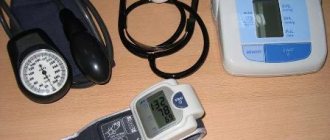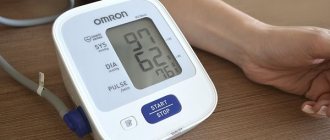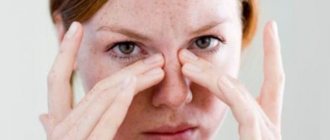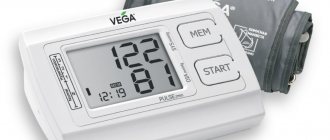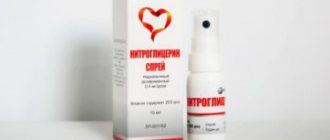Blood pressure measurement while lying down
Everyone knows how to measure blood pressure with a manual tonometer.
But measuring blood pressure with a mechanical tonometer is not always convenient. To simplify the process, modern technologies offer new instruments for measuring pressure. You can purchase an electronic blood pressure monitor at any pharmacy. Measuring blood pressure with an automatic tonometer is very simple. The technique for measuring blood pressure is as follows: put a cuff on your arm and press the “start” button on the device. If the cuff is put on correctly, OK and a circle symbol are displayed on the monitor. The electronic tonometer will inflate the cuff itself, take all measurements, and display blood pressure and pulse indicators (the number of heart beats per minute) on the screen. This device is convenient for those who need to measure blood pressure several times throughout the day. Your attending physician will tell you how often and how to measure.
It also has an arrhythmia indicator. They are easy to use and irreplaceable when it is not easy for a person to measure these indicators with a mechanical tonometer, for example, at the time of an attack. There are models equipped with built-in memory, convenient for hypertensive patients. The attending physician can view the history and dynamics of pressure changes while taking a particular drug.
There is an opinion that an electronic device often measures incorrectly, since with each subsequent measurement it shows different numbers. This happens because the device reacts to the slightest changes (fluctuations) in blood pressure. Therefore, in order to more accurately measure pressure, you need to take measurements 3 times in a row (with pauses of 5 minutes) and calculate the average result.
In semi-automatic electronic blood pressure monitors, air must be pumped in independently, and the numbers are reflected on the monitor. They have 3 types of cuffs that can be worn on the shoulder, finger, or wrist. The model with a finger cuff is prone to measurement inaccuracy. In terms of price, they are located between mechanical and electronic.
In 1906, an auscultatory method for measuring blood pressure was published by Russian professor S.N. Korotkov. The Korotkoff method of bloodless blood pressure measurement is the only method approved by WHO and recommended for use by doctors around the world to this day. The measurement is carried out with a sphygmomanometer, using a stethoscope to listen for Korotkoff sounds from the compressed artery.
This method measures pressure much more accurately. Korotkov described 5 phases of heart sounds heard during cuff deflation, of which:
- 1st phase (appearance of tones) – sphygmomanometer readings correspond to systolic pressure;
- 5th phase (disappearance of sounds) - diastolic pressure.
Every third person in the world suffers from hypertension. Cardiovascular diseases are in first place in mortality. Particular attention should be paid to your health in terms of the functioning of the heart and blood vessels.
If symptoms such as dizziness, headaches, or nausea occur, you need to check your blood pressure, learn how to measure blood pressure with a tonometer, and purchase a device that suits you.
- Eliminates the causes of pressure disorders
- Normalizes blood pressure within 10 minutes after administration
Many patients wonder why the measurement results are different if they measure their blood pressure several times a day while standing, sitting or lying down.
A person’s heartbeat can change constantly throughout the day, so during the measurement, blood pressure at a certain moment may be lower or higher than previous values.
To obtain accurate data, you need to use the tonometer every day at the same time, and the environment should not change. The fact is that the human body is dependent on daily biorhythms, which are similar when blood pressure is measured in the same environmental conditions.
In particular, blood pressure changes throughout the day under certain circumstances:
- Blood pressure becomes higher in the morning when a person is in a lying position.
- During the day the indicators become lower.
- In the evening, blood pressure rises again.
- The lowest blood pressure is observed at night, when a person is lying down and fast asleep.
Thus, if there is a goal to obtain accurate data, it is necessary to measure pressure every day at the same time. There is no point in comparing data obtained in the morning and evening.
Patients often wonder why blood pressure changes and becomes higher when measured by a doctor in a clinic. It is no secret that measurements with a tonometer need to be taken when a person is sitting, standing or lying down.
Research also shows that patients often experience the so-called white coat syndrome while in the doctor's office. This condition is not a disease, but a person experiences an involuntary increase in blood pressure due to a stressful situation and the nervousness that the patient experiences when visiting a doctor.
Meanwhile, such symptoms obtained while lying down, sitting or standing may be the first signal for the need to examine a person. This will avoid the development of serious diseases and all kinds of complications.
Blood pressure indicators are not constant; they depend on the physical and mental state of a person at certain points in life, time of day and conditions of measurement. For this reason, the tonometer must be used under the same conditions and at a certain time. It is also important to rest for five minutes before the test.
Two minutes after the examination in a supine position, it is recommended to additionally measure the pressure in a standing position to detect a sharp decrease in pressure. So-called orthostatic hypotension is most often found in older people, as well as in people with diabetes or taking vasodilator drugs.
There are cases when measurement results become constantly higher or lower, despite rest and compliance with all necessary recommendations. In this case, the tonometer is used at least three times with an interval of one minute. After this, the average value from the obtained data is calculated. It is also recommended to take a lying, standing and sitting position.
If jumps are observed constantly, and the data is noticeably higher or lower than normal, it is recommended to test the measuring device at the Metrological Laboratory or the local branch of RosTest.
To prevent external factors from influencing the measurement results, certain rules must be followed.
- Before taking the measurement, you should not smoke, drink alcohol, or drink coffee for at least an hour.
- On the eve of the study, it is necessary to empty the bladder, since with a full bladder, pressure readings become 10 mmHg higher. Art.
- Measurement should not be taken when a person is exposed to fear, stress or pain. This condition also makes the results higher.
It is important to ensure that the cuff is in the correct position. If it is located in the shoulder area, the distance to the elbow crease should be 2.5 cm. If the measurement is taken in the wrist area, the cuff is located 1 cm above the wrist crease.
Similarly, to get accurate results, you need to check how tight or loose the cuff is. The correct tension is considered if two fingers can be inserted under the cuff. With a tight fit, the figures will be much higher than the real ones.
The measurement location at the wrist or shoulder should be at heart level. When the position shifts by at least 1.5 cm, the results become 1 mmHg higher. Art.
The procedure should be carried out in a lying, standing or sitting position. The arm muscles should be relaxed. Otherwise, the pressure increases by 10 mm Hg. Art. You should also not talk, as excess tension causes an increase of 7 mmHg. Art.
It is necessary to ensure that the upper part of the arm in the shoulder area is not pinched by clothing. During the procedure, it is recommended to remove tight-fitting clothes; all this is in simple instructions on how to measure blood pressure correctly.
Before taking a second measurement, you need to rest for at least one minute. It is also important not to forget about daily biorhythms and conduct research at the same time of day.
Blood pressure is measured as follows:
- The patient is in a standing position or sits on a chair. The body is relaxed and rests on the back.
- The hand is freed from clothing and placed on the tabletop. The cuff is placed so that the balloon is at the level of the heart and above the brachial artery. The lower edge is located 2 cm above the ulnar fossa.
- The stethoscope is pressed firmly, without excessive force, to the crease of the elbow, where the greatest pulsation is observed. It is important that the head of the device does not come into contact with the cuff and tube.
- You need to make sure that the needle on the pressure gauge is at 0, the bulb valve is closed and air is quickly pumped into the cuff until the pulse disappears. Do not re-inflate the cuff. Next, the bulb valve slowly opens, the air pressure gradually decreases.
- You need to wait for the first tone in the stethoscope. The first indicator of the tonometer needle will indicate the upper systolic pressure. Continuing to deflate, you need to record the indicator when the sounds completely disappear; this figure indicates the lower diastolic pressure.
It is best to measure at least twice with a short break, and then get an average result.
When measuring in a standing position, use a special stand with an adjustable height and a supporting surface for the hand and the measuring device.
The height of the stand is selected so that the middle of the cuff is located at heart level.
Symptoms of hypertension
To determine the cause of pressure surges, you cannot do without visiting a doctor who will prescribe the necessary examination. If such symptoms appear, this may be the beginning of hypertension:
- pressure surges;
- cardiopalmus;
- headache, dizziness;
- blurred vision;
- “floaters” (black dots) in the eyes;
- excessive sweating;
- swelling on the face;
- apathy and chronic fatigue;
- drowsiness;
- irritability.
- numbness (coldness) in the fingertips.
You can’t take this lightly, like any other; this disease is easier to stop in its early stages. And surges and high blood pressure cause enormous harm to the heart and blood vessels. Heart and vascular diseases, kidney pathologies can cause increased blood pressure.
Why does pressure change when changing position?
It is generally accepted to take measurements while sitting on a chair with support towards your back, since in a hunched position the pressure may be increased.
It is in a sitting position on an armchair/chair with a backrest that a person can achieve the best relaxation before taking blood pressure measurements. Some patients find it difficult to take a sitting position, so doctors are forced to measure blood pressure while lying down. In this case, measure the pressure when the patient's arm is directly along the body at the level of the heart. Measuring blood pressure while standing is strongly discouraged, as a person cannot relax properly when standing.
In most cases, the disease proceeds almost unnoticed, and you can only find out about it during an examination with your doctor.
If this is not done, the disease can progress, causing equally dangerous complications. Many experts recommend regularly measuring blood pressure for personal control. This will allow timely detection of this dangerous disease in order to prevent a deterioration in overall health. Blood pressure can be measured not only at an appointment with a specialist, but also at home.
It is recommended to do this in a calm and quiet environment in one of the following positions: standing, sitting or lying on a comfortable sofa. In this way, you can obtain the most reliable information about your health status. In addition, it is possible to determine whether there is a risk of developing more serious and dangerous diseases. But first you need to find out whether measuring pressure while lying down and sitting is reliable?
As a rule, a person’s posture itself has little effect on the tonometer’s readings; the main role is given to the location of the shoulder or hip on which the measurement is made. But preference when measuring is given to a sitting position, if possible. If the patient is in serious condition or is unable to sit down, measurements are taken when he is in a lying or semi-sitting position. Measurements are not taken while standing.
One of the reasons why there are different pressure values in different positions is due to the different volumes of blood that the heart pumps out.
In an upright position, the heart needs to pump out a larger volume of blood, which inevitably leads to an increase in blood pressure. Also, one of the factors for increased blood pressure when measured standing is tension in the leg muscles.
| Daily time | Changes in the body |
| Morning | After waking up and performing basic movements, a person’s blood flow increases. |
| Daytime | After the body gets used to the active phase, pressure readings slightly decrease and stabilize. |
| Evening | Usually during this period of the day the values on the tonometer increase slightly compared to the previous daytime values. |
| Night | The lowest pressure values are standard. The person is located on his side or back, as relaxed as possible in his sleep. |
If you doubt whether it is possible to measure pressure while lying on your back, then it is worth considering some features. When a person is horizontal, the blood flow directed to the heart accelerates, and in a vertical position - vice versa. Awakening entails a switch from a calm state to active action. All important systems demonstrate energetic and enhanced work.
In what position is it preferable to measure blood pressure?
At the moment, it is important to measure blood pressure both while lying and sitting.
Here the main role is played not so much by the position of the body as by the position of the hand itself, on which the pressure level is measured. The hand must be placed only along the body. The level of relaxation of the body and the arm itself, which, moreover, should be slightly raised to the level of the chest, also plays an important role.
If the patient decides to measure blood pressure while lying down, then he needs to slightly raise his arm so that it is perpendicular to the body. It is also not recommended to talk or make sudden movements during the procedure.
The process itself should consist of three measurements with an interval of ten minutes. This approach will allow you to most accurately determine your blood pressure level. Moreover, after completing the procedure, an average indicator is calculated from three measurements, which will be the most accurate.
Before measuring blood pressure, familiarize yourself with some factors that may influence the final result:
- Stressful situations, anxiety, fear, excitement and excessive physical activity can increase blood pressure levels;
- foods and drinks containing caffeine and tannins also have the ability to significantly increase blood pressure levels;
- Taking a hot bath or shower, prolonged exposure to cold or, on the contrary, hot air can also have a colossal effect on blood vessels, causing them to alternately expand and contract. Thus, the pressure level either increases or decreases;
- alcoholic drinks and tobacco products have the properties to dilate and constrict blood vessels, thereby leading to instability of hemodynamic parameters;
- electrical impulses that come from surrounding foreign devices can also affect the operation of the electronic tonometer. As a result, the final figures may not be entirely accurate.
In order for the final blood pressure readings shown by a special measuring device to be more accurate, it is necessary to take into account a number of factors during the measurement process.
Why is there a big difference between upper and lower blood pressure?
The lying and sitting positions when measuring blood pressure are fundamentally different in the mechanism of blood supply to internal organs. In this regard, each location of the body corresponds to different blood pressure. When you change position, the pressure changes. If a person sat for a long time and then stood up, his blood pressure will first drop sharply due to the outflow of blood from the brain (orthostatic hypotension), and then become higher.
Measurement Rules
Normal blood pressure in an adult is (100-125) per (60-75) mm Hg. Art. These indicators are individual, depending on gender, age and even place of residence. With each decade of life lived, normal blood pressure values increase by an average of 3 mm Hg. Art. Deviations:
- low blood pressure is considered if the data is less than 100 to 60;
- high - more than 130 to 80.
But before focusing on the norms, you need to measure blood pressure correctly. Before starting measurements, the patient is recommended to rest for 10-15 minutes. 5 deep breaths before the procedure allow you to normalize your pulse. Smoking, drinking coffee and alcoholic beverages are not recommended at least an hour and a half before the start of the study.
The readings may be different on two arms, so for reliable results you need to measure blood pressure on both arms, and in subsequent times take measurements on the arm with higher readings.
The arm on which the measurement is taken in a sitting position should rest relaxed on the table with the elbow, be free of clothing and be at a right angle to the body. When lying down, blood pressure is measured by placing a soft pillow under the elbow so that the arm is at the same level as the patient’s heart. You cannot talk or move during the procedure. When using an electric blood pressure monitor, your mobile phone must be kept away from the device.
– You need to contact a general practitioner or family doctor. A referral to a cardiologist will be made if resistant pressure is detected.
Myth 2: High blood pressure can be caused by back problems, hernias, protrusions, etc.
Professor, Doctor of Medical Sciences, President of the Association of Family Doctors of Kazakhstan Damilya NUGMANOVA (photo - Oleg Spivak)
– If your blood pressure rises and no one is chasing you at this moment, if you are not under stress or, for example, are not setting sports records, then this is already wrong. In a healthy person, blood pressure does not rise out of the blue. Even if there are intervertebral hernias, they should not increase blood pressure.
Hernias can give some kind of tension, a feeling of tension, headache, etc., but they cannot sharply increase the pressure. 220 to 120 is already a crisis; in this situation, the local therapist made the correct diagnosis. In 95% of cases of arterial hypertension, the cause is unknown and only 5% is so-called secondary hypertension.
For example, with excess obesity, kidney disease, endocrine system. These are the diseases that lead to high blood pressure. In such cases, if a person removes the risk factor and, for example, loses weight or starts doing physical exercise for 30 minutes every day until shortness of breath, then non-drug treatment helps, and the person can do without medication, and his blood pressure normalizes.
Myth 3: Constipation is the cause of high blood pressure
– Nowhere in the literature is there evidence that constipation causes an increase in blood pressure. Intra-abdominal pressure increases. Sometimes, when gases accumulate, the aorta is compressed and blood pressure increases. This is a normal physiological reaction.
Myth 4: pressure can be measured as conveniently and whenever you want
– Pressure must be measured at the same time. For arterial hypertension, it is advisable to measure blood pressure in the morning and evening. Better on both hands than on one. And the difference between the right and left hand should not be big. If the difference is more than 10-15 mm. mercury column, then it’s worth thinking about atherosclerosis.
We recommend that doctors measure blood pressure in the legs as well. And if you measure your blood pressure while lying down, then measure it while lying down all the time. But it is still advisable to do this while sitting, because the doctor places the patient on the couch in exceptional cases. Do not strain too much when measuring blood pressure. When measuring, there should be a right angle between the thigh and the lower leg.
If you have been involved in sports, you cannot immediately measure your blood pressure. You need to rest for 10 minutes and breathe. If you run a marathon now, your blood pressure will jump to 170, even if you are not hypertensive. A person coming home hungry, cold and measuring his blood pressure will see 80 to 50. The main thing is what the resting pressure is.
Myth 5: There is high blood pressure, and there is low blood pressure, hypotension
- There is no such thing. Some claim that due to hypotension they cannot get up without a cup of strong coffee. This is nothing more than an addiction to caffeine. A blood pressure of 90 over 60 is great. There is no such thing as “working pressure”. And there is no such thing as an “age norm.” Our doctors, unfortunately, do not always know this and begin asking patients questions about work pressure, telling a 50-year-old woman that 150 over 90 is her age norm. And there is no such disease as NCD or vegetative-vascular dystonia - these diagnoses are convenient for lazy doctors. There is either depression or hypertension.
Myth 6: headache is one of the signs of hypertension
- It's a delusion. But when black spots appear in the eyes or vision is patchy, these are already signs of a hypertensive crisis. And if you had 90/60 all your life and suddenly it became 140/90, then this is already a crisis.
Myth 7: Hypertension can be treated with a course; constant medication is not necessary.
– Arterial hypertension is a condition that requires daily medication, regardless of how you feel. You cannot stop taking medications, because hypertension will return.
Myth 8: problems with blood pressure are for “sluggish” people
- No. Hypertensive patients, unlike other patients, are people who feel great. These are lively, active, energetic people who work hard and manage to do everything. And then they die from a heart attack while running. They don’t feel the pressure, it never manifests itself. This is why we call hypertension the “silent killer.”
If there is no timely treatment, the disease can progress rapidly, which is dangerous with a number of complications. To monitor its progress, it is necessary to systematically monitor the state of blood pressure, which will help to quickly take measures to prevent deterioration in health.
Blood pressure can be measured not only in medical institutions, but also at home if you have a special meter - a tonometer. How to measure blood status correctly, and is it possible to measure blood pressure while lying down, or is it better to do it in a sitting position?
In medicine, a generally established rule is to measure pressure when a person sits on a chair, leaning on its back. With a hunched or other incorrect posture, blood pressure may increase, but when a person is in a sitting position with stable back support, his body relaxes as much as possible, which makes it possible to more accurately determine the state of blood pressure.
In a lying position
According to experts, it is permissible to measure blood pressure in a supine position, but the tonometer may show the result a little higher than it actually is, by about 6 mm. rt. Art., which is not considered a critical indicator.
When the condition of a hypertensive patient is very painful and he is unable to take a sitting position, the pressure is measured in a supine position. In this situation, the patient's arm should be located along the body at the same level as the heart.
In a standing pose
Doctors do not recommend that patients take blood pressure measurements in a standing position, since such a position does not allow a person (especially if they feel unwell) to relax as much as possible, which significantly affects the tonometer readings.
It is important to pay attention to the position in which blood pressure is usually measured. The pressure in lying down is lower than in sitting because the person is in a more relaxed state.
It is advisable to measure blood pressure while sitting. This is how you can get the most reliable indicators.
It is also worth noting that the obtained blood pressure indicators are not constant. Since they are influenced by a huge number of factors, they can change significantly throughout the day. Blood pressure is affected not only by the emotional, but also by the physical state of a person.
The time of day and the position in which it is measured also play a big role. It is for this reason that you need to use the tonometer at the same time and in the same body position. As a rule, approximately a few minutes after measuring the pressure in a lying position, it is additionally recommended to perform similar actions only in a standing position. This allows you to determine a sharp drop in blood pressure.
It is important to note that so-called orthostatic hypotension is most often found in the elderly, in patients with diabetes mellitus and in people who constantly take special vasodilating drugs.
So is it possible to measure blood pressure while lying down? This article states that this can be done because the differences from measuring in a different position will be minimal. In order to avoid low blood pressure while lying down, it is necessary to follow a number of rules that are required to obtain the most accurate results.
Measurement Rules
Types of tonometers
Pressure is measured with a special device - a tonometer, which can be:
- mechanical
- semi-automatic
- automatic
The device consists of:
- cuffs - put on the hand;
- pears - for pumping air into the cuff
- pressure gauge - recording pressure indicators
- Phonendoscope
You need to familiarize yourself with the rules of how you can measure pressure with different tonometers in order to choose the one that is convenient for you. When purchasing a tonometer, it is very important to choose the right cuff. The pneumatic cuff is put on the arm and compresses it when air is pumped; it must correspond to the volume of the arm. Cuffs are made in different sizes (for overweight people, for children). Tonometers from Omron have proven themselves well.
To get reliable, correct numbers, you need to know how to measure blood pressure.
Many people believe that it does not matter on which hand to measure the pressure. However, the measurements on both hands differ by 10-20 mmHg. If the difference in indicators depending on which arm you measure the pressure on is much greater (than 10-20 units), then this may indicate a dissection of the aortic walls - a rare and serious disease. There is no exact confirmed data on which hand the pressure is higher. In some people (about 50% of the population), the pressure on the right hand is higher than on the left. For others (45%) it’s the opposite. This depends on the individual characteristics of the person and is considered the norm. To obtain the most accurate data, you need to measure the pressure on both hands. In the future, determine for yourself on which hand it is correct to measure the pressure, since there is no consensus.
There are different methods for measuring blood pressure. To get the correct readings when measuring blood pressure, you need to know how to measure blood pressure correctly. The following rules must be observed:
- an hour before, do not smoke, drink alcohol, or drink coffee;
- create a calm, comfortable environment;
- take a sitting position, relax
- empty your bladder;
- place the hand for putting on the cuff on the table so that the elbow is approximately at the level of the heart
- don't talk or move
The room must be warm; the cold causes the blood vessels to contract and the readings will be distorted. If you need to re-measure, pause for 5 minutes, relaxing the cuff.
You need to measure the pressure 2-3 times, take the average. Sometimes the patient experiences excitement at the sight of a white coat. If a person was lying down and suddenly stood up, the pressure will also increase. We need to give the person time to calm down and relax.
Blood pressure shows the work of the heart: upper (systolic) – the heart is maximally compressed, lower (diastolic) – maximally relaxed. Optimal pressure (norm) 120/80 mm Hg. Art. Indicators 100-130/60-85 are considered satisfactory. Deviations from these numbers in any direction indicate some pathologies in the body, the onset of a disease. The reasons may be: hormonal imbalance, vascular, heart, kidney diseases. It is necessary to undergo examination. Arterial hypertension (AH) has 3 degrees of development:
- high blood pressure – 130-139/85-89;
- 1st degree hypertension – 140-159/90-99;
- 2nd degree hypertension – 160-179/100-109;
- Stage 3 hypertension – above 180/above 110.
These numbers may change slightly as you age.
How do indicators change when changing body position?
The presence of hypertension can be detected early if blood pressure is regularly monitored.
The measurement is best carried out throughout the day at home, in a quiet environment, standing, sitting or lying on the bed. This will allow you to obtain more accurate data and find out whether there is a threat of developing serious diseases.
Measurement Rules
It is important to remember that it is influenced not only by the time of day, but also by the position in which this pressure measurement is performed.
As you know, a person’s heartbeat changes dramatically throughout the day. That is why, before measuring blood pressure, you need to pay attention to what time it is.
The indicator may be significantly higher or lower at certain times of the day. The thing is that the human body is dependent on constant biorhythms, which have a certain similarity at the moment when pressure is measured under identical environmental conditions.
There are several fundamental factors that have a significant impact on blood pressure during the day:
- lying down, blood pressure rises early in the morning, since at this time the person is still in bed after sleep;
- gradually throughout the day these indicators decrease;
- In the evening, each person's blood pressure rises slightly;
- The lowest blood pressure is observed at night, when a person is in a state of sound sleep. This is due to the fact that he is at rest and directly in a supine position.
So why does lying down raise blood pressure in the morning? This is due to the fact that while in a horizontal position, the blood flow to the heart is much stronger than in a standing position. In addition, immediately after waking up, the human body moves from the resting stage to a more active state, therefore, all the processes occurring in it, as well as the work of internal organs and systems, become intensified.
Measurement Rules
To carry out monitoring, special modern devices are used that can store more than 100 measurements of pressure and heart rate in memory, indicating the date and time of the study.
After measurements are taken while standing, sitting or lying down, the data is transferred to a computer, where the results are processed using a special computer program.
Elena Malysheva’s guests will tell you how to correctly interpret the monometer readings in the video in this article.
The favorite disease of grandparents - blood pressure, or hypertension - is accompanied by many fairy tales and myths. Professor, Doctor of Medical Sciences, President of the Association of Family Doctors of Kazakhstan Damilya NUGMANOVA suggested that we destroy these myths.
Myth 3: Constipation is the cause of high blood pressure
Myth 7: Hypertension can be treated with a course; constant medication is not necessary.
Video on the topic
Since the results of measuring blood pressure with a tonometer at different times of the day can differ dramatically, you need to choose a specific time at which to measure it daily. It is advisable to do this several times a day at intervals of a quarter of an hour. The average is the most reliable. If the pressure level is too high over a certain period of time, then you must immediately contact a qualified specialist to determine the reasons for such high levels.
This point should not be ignored, as it may be a sign of a terrible disease of the cardiovascular system. In this case, you need to immediately conduct an appropriate examination to determine the state of the body and identify the true reasons that influenced the deterioration of health. You should not delay going to the doctor, so as not to complicate the situation even more.
How to beat HYPERTENSION at home?
To get rid of hypertension and cleanse blood vessels, you need.
Factors that can distort the results
| Reasons influencing the inaccuracy of measurement results | How exactly is it violated? |
| Stressful situations, anxiety, anxiety and intense physical activity, as well as constipation | Increase blood pressure |
| Drinks and foods with caffeine and tannin | Significantly increases blood pressure |
| Extremely high or low air or water temperatures | A hot shower or bath, hot or cold weather contribute to the dilation or constriction of blood vessels, which also provokes a sharp increase or decrease in blood pressure |
| Alcoholic drinks and smoking | They have the ability to narrow and expand the lumen of the arteries, thereby disrupting hemodynamics |
| Electrical impulses of devices | They interfere with the correct operation of the automatic electronic tonometer; as a result, the measurement result will be incorrect |




